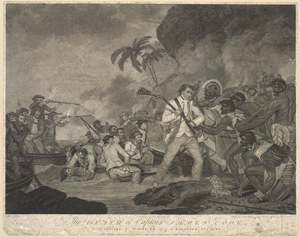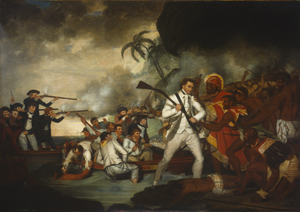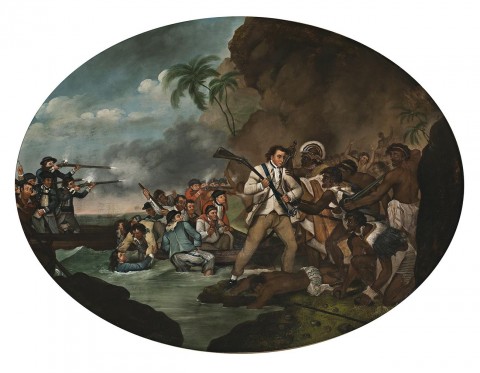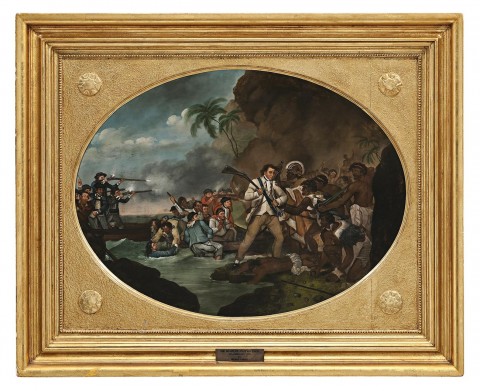THE DEATH OF CAPTAIN JAMES COOK, c.1781 – 84
ATTRIBUTED TO GEORGE CARTER
oil on metal
56.5 x 74.5 cm (oval shaped)
bears inscription verso: This Picture / is to be ALWAYS KEPT by Order / Lady Daresbury
Collection of Lord and Lady Daresbury, Walton Hall, Cheshire, United Kingdom
Thence by descent
Mrs Greenall (daughter-in-law of the above), United Kingdom
Marshall Spink, London
Tony Cowden, London and Sydney, by 1979
Julian & Miriam Sterling Collection, Melbourne
Thence by descent
Private collection, Melbourne
Captain Cook’s Voyages, City Museums and Art Gallery, Birmingham, United Kingdom, 23 August – 11 November 1979 (label attached verso)
Death of Captain Cook, 1781, oil on canvas, 151.2 x 213.4 cm, in the collection of the National Library of Australia, Canberra
Death of Captain James Cook, 1783, oil on canvas, in the collection of the Bernice Pauahi Bishop Museum, Honolulu
The Death of Captain James Cook by the Indians of O, Why, ee, one of the Sandwich Islands, 1779, engraving after George Carter published by George Carter, Sayer and Bennett, London, 1784, in the collections of the National Maritime Museum, Greenwich, London, National Library of Australia, Canberra and the State Library of New South Wales, Sydney.
SLNSW Carter.jpg

GEORGE CARTER
Death of Captain James Cook by
the Indians of O, Why, Ee, one of
the Sandwich Islands, 1784
engraving
42.5 x 59.37 cm
courtesy of State Library of New South
Wales, Sydney
Throughout time the death of the hero has inspired great art. In the eighteenth century it reached new heights in Benjamin West’s revolutionary history painting, The Death of General Wolfe, 1770 (National Gallery of Canada, Ottawa). Later, Nelson’s death at Trafalgar in 1805 led to a further wealth of history paintings enshrining the noblest of patriotic sentiments. In between, on 14 February 1779 at Hawaii, fell the death of Captain James Cook, bold navigator of uncharted waters and famed discoverer. His untimely demise and published Discoveries captured the public’s imagination, expressed in grief, fascination and several forms of art, theatre and literature. Francesco Bartolozzi’s engraving, The Apotheosis of Captain Cook after Philippe-Jacques de Loutherbourg, based on a drawing by John Webber (1751 – 1793), captured the mood – Cook, holding a sextant rather than a sword, ascending heavenwards in clouds of glory above Kealakekua Bay, accompanied by Britannia and heralded by Fame.1 The image had its origin in the 1785 pantomime Omai: or, A Trip Round the World by John O’Keefe, performed at the Theatre Royal, Covent Garden. In 1789 Covent Garden again saw the opening of the ‘Grand Serious-Pantomimic-Ballet’ The Death of Captain Cook, a version of the French pantomime, La Mort du Captaine Cook, presented in Paris in 1788. Of the latter, Bernard Smith observed: ‘… the conventions of the theatre required that the death of Cook should not be presented with strict adherence to fact but that he should be presented ideally as a tragic hero. On the other hand, the costumes and settings were to be presented as faithfully as possible. Idealized action and realistic staging was combined in the exotic pantomime’.2 George Carter’s paintings follow suit.
Chief among the celebrated painted versions of Cook’s death are those by John Webber, artist on Cook’s last voyage, Carter and Johann Zoffany (1733 – 1810). None were eyewitnesses, relying on the accounts of others for their visual eulogies of the dead hero.3 Webber’s oil painting and watercolour are in the State Library of New South Wales, Sydney. Based on Webber, Francesco Bartolozzi’s and William Byrne’s engraving of 1784 (National Portrait Gallery, Canberra) became one of the most well known images of the event. Portrayed as the man of peace, Cook holds up his hand to stop his marines shooting the islanders. The drama is heightened by the choice of the very moment before Cook is struck down from behind by a dagger. Zoffany carried this ennoblement even further in his oil, The Death of Captain James Cook, 14 February 1779, c.1794, (National Maritime Museum, London). Influenced by West’s painting of General Wolfe, in which the subject is depicted as a Christ-like figure amid other references to the traditional imagery of the ‘Lamentation’, Zoffany further elevated his principal figures by drawing them from ancient classical sources. Cook’s pose was derived from The Dying Gaul, a Roman copy of a lost Hellenistic sculpture (Capitoline Museums, Rome). The native figure bending over Cook is from Myron’s Discobolus (British Museum, London). While the Hawaiian helmet worn by the bending native echoes those of ancient Greece, it added a touch of actuality, being based on the one given to Cook by a Hawaiian chief in 1778.
NLA Carter.jpg

GEORGE CARTER
Death of Captain Cook, 1781
oil on canvas
151.2 x 213.4 cm
courtesy of National Library of
Australia, Canberra
Other works, which show a more bellicose Cook, do not so much raise the question of what actually happened at Kealakekua Bay in 1779, but offer different moments of the skirmish and images by which to glorify the hero. John Cleveley’s (1747 – 1786) early watercolour of Cook’s death, based on drawings by his brother James, a carpenter on Cook's ship Resolution during the Third Voyage, shows Cook as a fighter against overwhelming odds. 4 George Carter gives Cook a similar role, his musket raised as a club in all three of his oil paintings of Cook’s death – National Library of Australia, Canberra; Bernice Pauahi Bishop Museum, Honolulu; and our work on offer. Settings and actions are the same; variations are in the details. Moved from the flat shores of the bay to a heightened cliff-enclosure amid threatening sky, the artist evokes the drama of a theatre set. Fortress land seeks to conquer open sea, the angle of Cook’s gun repeated in the palm trees and rock profile, increasing the sense of onslaught. Carter’s portraits of the British soldiers and sailors, together with the Hawaiians, are striking. Above all, the confrontation of Cook, bare headed and dressed in white, and the islander chief, crowned and robed in splendour, has a touch of the martyr about it. Cook as the hero in white is present in all three paintings – completely white in the Canberra painting, in the two others white jackets replacing the traditional Navy jacket of blue. The purity of white, like a light shining in darkness, spotlights Cook’s action, emphasised by his central position and slain foe at his feet. Alone he faces the onslaught, marines and soldiers resisting en masse behind. The Honolulu painting has an unanswered change in the colour of the otherwise identical uniforms of the party firing from the boat – the red for marines in the Honolulu version transformed into blue for naval officers for the other two.
The gifted Carter exhibited at the London Royal Academy and was known for his historical portraits, his dramatic approach owing something to his one time friend, the American artist John Singleton Copley (1738 – 1815).5 That Carter painted three versions of Cook’s death is not unusual for the time. West made at least five paintings of The Death of Wolfe, each with its own variations, the prints being a further great success. Carter’s 1784 engraving, The Death of Captain James Cook by the Indians of O.Whyee, one of the Sandwich Islands, 1779, based on the Canberra painting, was likewise very popular. Like West, Webber and Zoffany, Carter’s oil paintings idealise the event, Cook immortalised in the glorious realms of myth. The oval composition of our painting adds to its closer focus, the profiling of figures reminiscent of classical Greek relief sculpture.
1. The Apotheosis of Captain Cook, 1794, engraved by Francesco Bartolozzi after Philippe-Jacques de Loutherbourg, based on a drawing by John Webber. An impression is in the National Library of Australia, Canberra
2. Smith, B., European Vision and the South Pacific 1768-1850, Oxford University Press, London, 1960, p. 83
3. Williams, G., The Death of Captain Cook: A Hero Made and Unmade, Harvard University Press, Cambridge, Massachusetts, 2008, p. 73
4. One of a set of four watercolours sold by Christie’s, London, on 23 September 2004, lot 35
5. Gall, J., et al, Library of Dreams: Treasures from the National Library, Canberra, 2011, p. 24
DAVID THOMAS

